Why Rear Loader Garbage Trucks Still Dominate Waste Management in 2025
Explore how rear‑loader garbage trucks power modern waste management, from types and components to specs, maintenance, and leasing options.
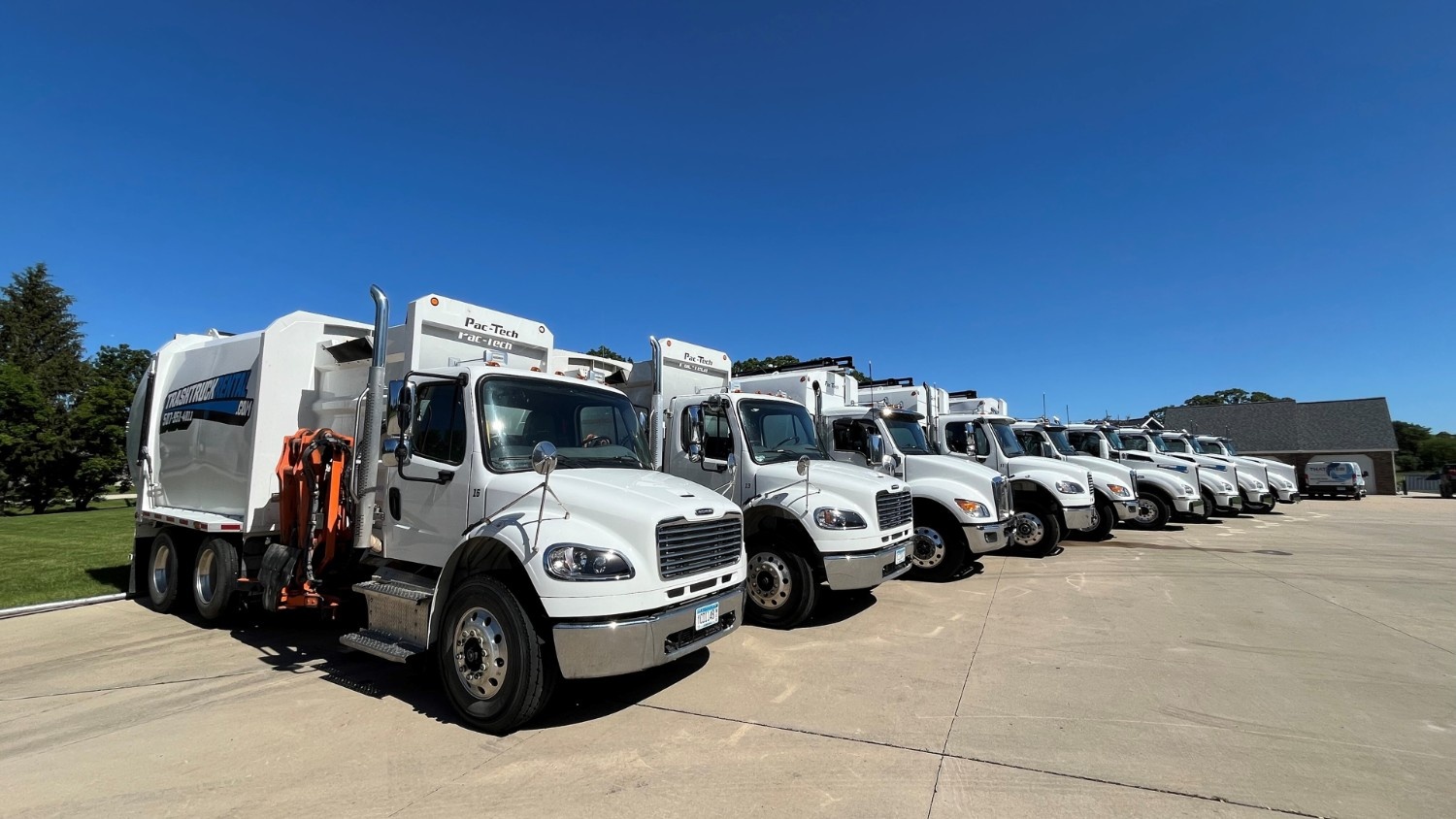
Explore how rear‑loader garbage trucks power modern waste management, from types and components to specs, maintenance, and leasing options.

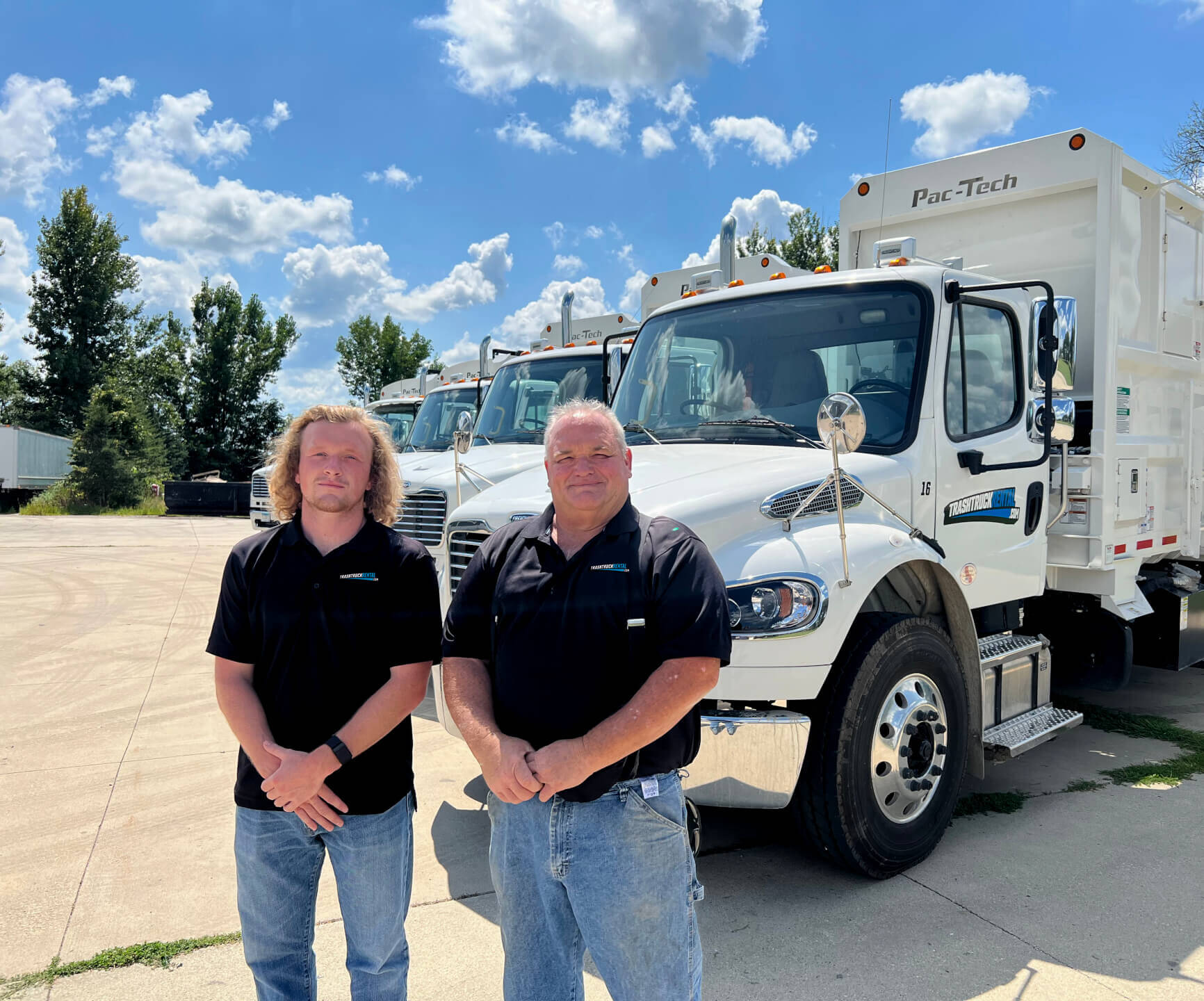
In waste management, a rear loader garbage truck is a refuse vehicle designed to collect trash from the back. Crews manually load bags or bins into a rear hopper, where a hydraulic blade compacts the waste into the body of the truck. Once full, the load is ejected at a landfill or transfer station via a push blade or tipping mechanism.
Rear loaders are known for their versatility and rugged build, making them a staple in mixed-use routes, from city streets to alleys where automated trucks can’t operate effectively.
They handle a wide range of container types, irregular bulk waste, and hand-loaded debris, which makes them especially useful for downtown pickups, small businesses, and construction cleanups.
While newer technologies, such as side loaders, dominate automated residential routes, rear loaders remain essential for operations that require flexibility. They’re ideal for routes that don’t conform to standardized bin setups or require a crew to manage complex pickup scenarios.
In short, if your waste collection demands adaptability over automation, the rear loader is still one of the most reliable tools in the fleet.
Rear loader garbage trucks follow a straightforward but labor-intensive process.
Step 1: Crews load waste into a rear hopper, either manually or with the help of tippers for wheeled bins.
Step 2: Once the trash is in, a powerful hydraulic blade sweeps it into the truck body, compacting it to maximize capacity. This cycle repeats until the truck reaches full load.
A typical setup includes a driver and one or two loaders working at the back. The crew walks alongside the vehicle, collecting bags, bins, or bulky items and feeding them into the hopper.
Rear loaders are compatible with a wide range of waste types, including household trash, commercial debris, and construction materials.
Step 3: Once the route is complete, the driver engages the ejection mechanism, either a push blade or hydraulic tilt system, to unload the compacted waste at a landfill or transfer site.
This hands-on approach may require more labor, but it gives operators the flexibility to service complex, irregular pickup zones, something automated systems often can’t handle.
In an era of automation and one-person side loaders, it’s easy to assume rear loaders are on their way out, but that couldn’t be further from the truth. Rear loader garbage trucks remain essential for waste management companies that deal with mixed waste types, complex route layouts, or unpredictable pickup conditions.
That makes them ideal for routes that blend homes, businesses, and public spaces, especially in older neighborhoods with narrow streets or limited curb access.
Unlike automated systems that require standardized bins and placement, rear loaders give your crew control. Got an alley pickup? A pile of bulky furniture? A broken bin with loose bags? Rear loaders can handle it without needing to bypass the stop.
That’s why, even with the rise of automation, waste management companies across the U.S. continue to rely on rear loader trucks to fill critical gaps.
Rear loaders aren’t just standalone units; they play a strategic role within diverse waste collection fleets. Here’s how operations put them to work:
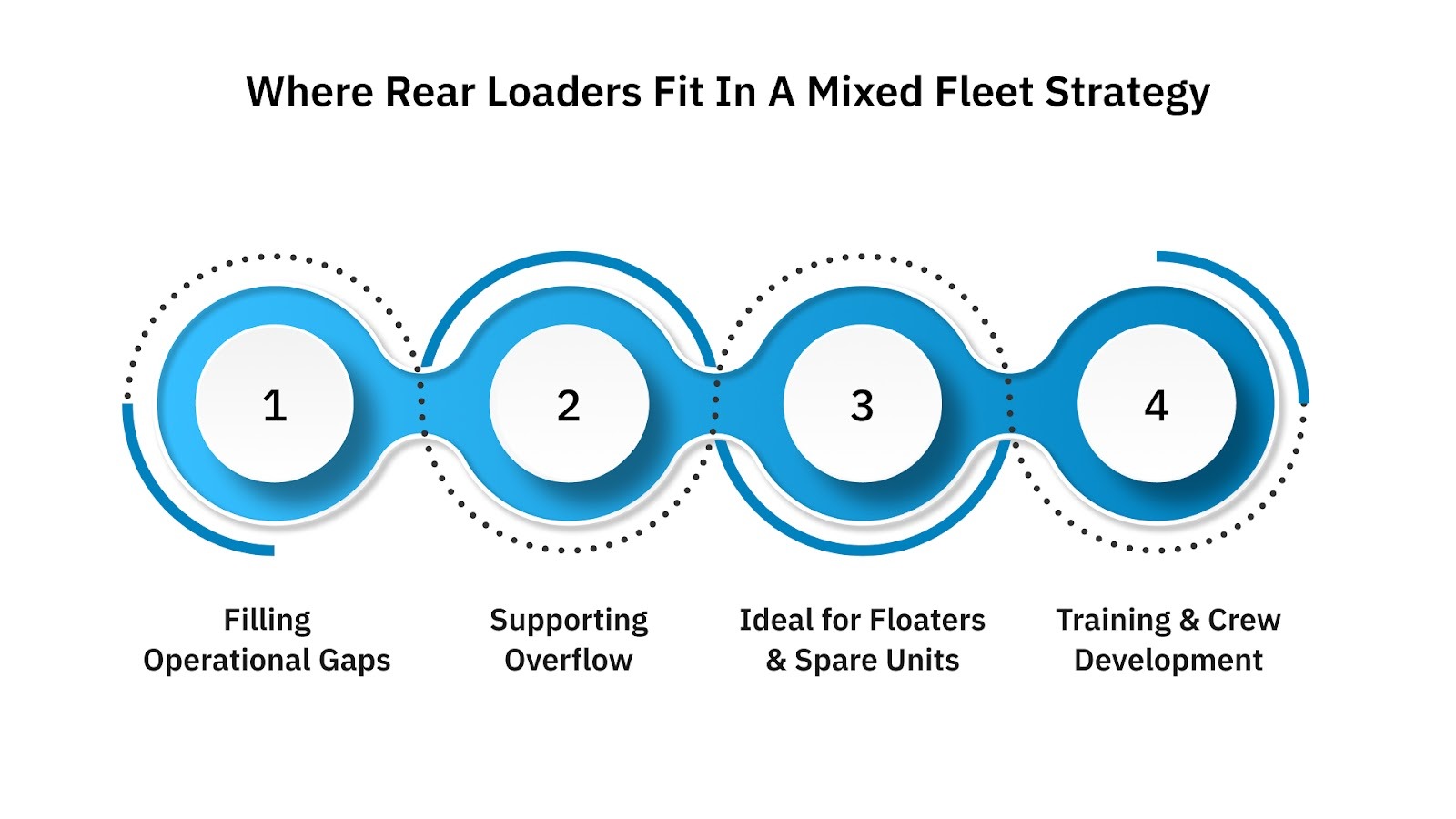
This role-focused approach shows why rear loaders remain relevant not just because of what they can do, but how they fill critical logistical and operational roles when flexibility matters most.
Rear loaders come in different sizes and specs, and choosing the right one depends on your route demands, waste volume, and how hard your trucks work day to day. Here’s a breakdown of the most common rear loader types in waste management fleets:
Each configuration is built for a specific load profile. Lighter models offer better maneuverability, while heavy-duty units are engineered for volume and durability.
By matching the truck type to the route environment and waste stream, operators can improve pickup efficiency and reduce unnecessary strain on the equipment or crew.
Understanding the major parts helps you diagnose issues, specify trucks correctly, and prioritize maintenance. Below is a breakdown of key components and their roles.
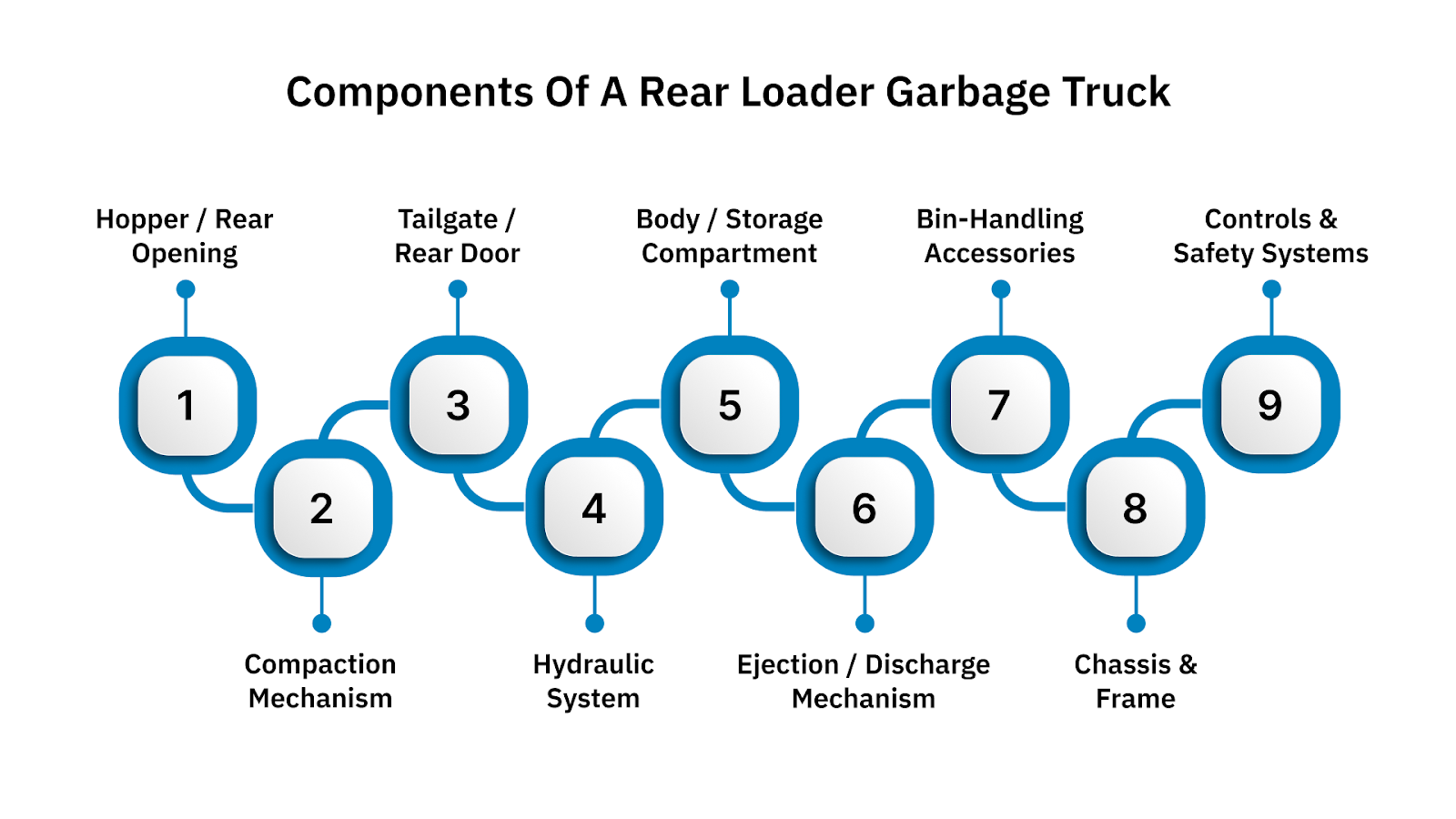
The rear-facing bin entry point. Trash, bags, or bins are loaded into the hopper before compaction. Some trucks include built‑in tippers or guides to assist with wheeled bins.
The system that compresses the waste into the body. It often includes:
The rear hatch opens when unloading. It seals tightly during transport to prevent spillage. Some tailgates have self-lubricating features or fewer lubrication points to reduce upkeep.
The backbone that powers compaction, tailgate actuation, and any bin tippers. It includes pumps, cylinders, hoses, and control valves, all under high pressure.
Where compacted waste is stored during transport. Built with thick, abrasion-resistant steel and reinforced panels to endure constant impact and loading.
Used at dump sites to unload compacted waste. Two common systems:
Optional but common in many models:
The base structure supporting all components. Must be strong, rigid, and resistant to corrosion. Undercarriage strength is key when trucks carry heavy loads repeatedly.
Cables, switches, sensors, backup alarms, and lighting are the systems that allow safe and controlled operation of the compaction and dumping processes.
After understanding the components, the next step is planning for the long run, how your rear loader ages, where it wears, and how to maintain peak performance year after year.
A rear loader garbage truck isn’t just a piece of equipment; it’s a multi-year investment that can make or break route efficiency over time. Understanding the typical lifespan, wear points, and maintenance cadence helps you plan smarter, not just for uptime, but for budget forecasting and fleet rotation.
Most well-maintained rear loaders last between 7 to 12 years, depending on route intensity and maintenance quality. Urban, high-density routes may wear components faster, while rural or low-frequency service areas see longer lifespans.
Rear loaders endure constant physical stress. These components typically see the most wear:
To keep a rear loader running reliably through its service life:
Track total compaction cycles or route hours to determine replacement vs. rebuild timing. A truck that’s well-maintained but reaching the upper end of compaction counts may benefit from a mid-life overhaul instead of full replacement.
Choosing the right rear loader isn’t just about capacity or brand; it’s about aligning the truck with your real-world route demands, crew setup, and operational goals. Here’s how to make a decision that pays off in both uptime and ROI:
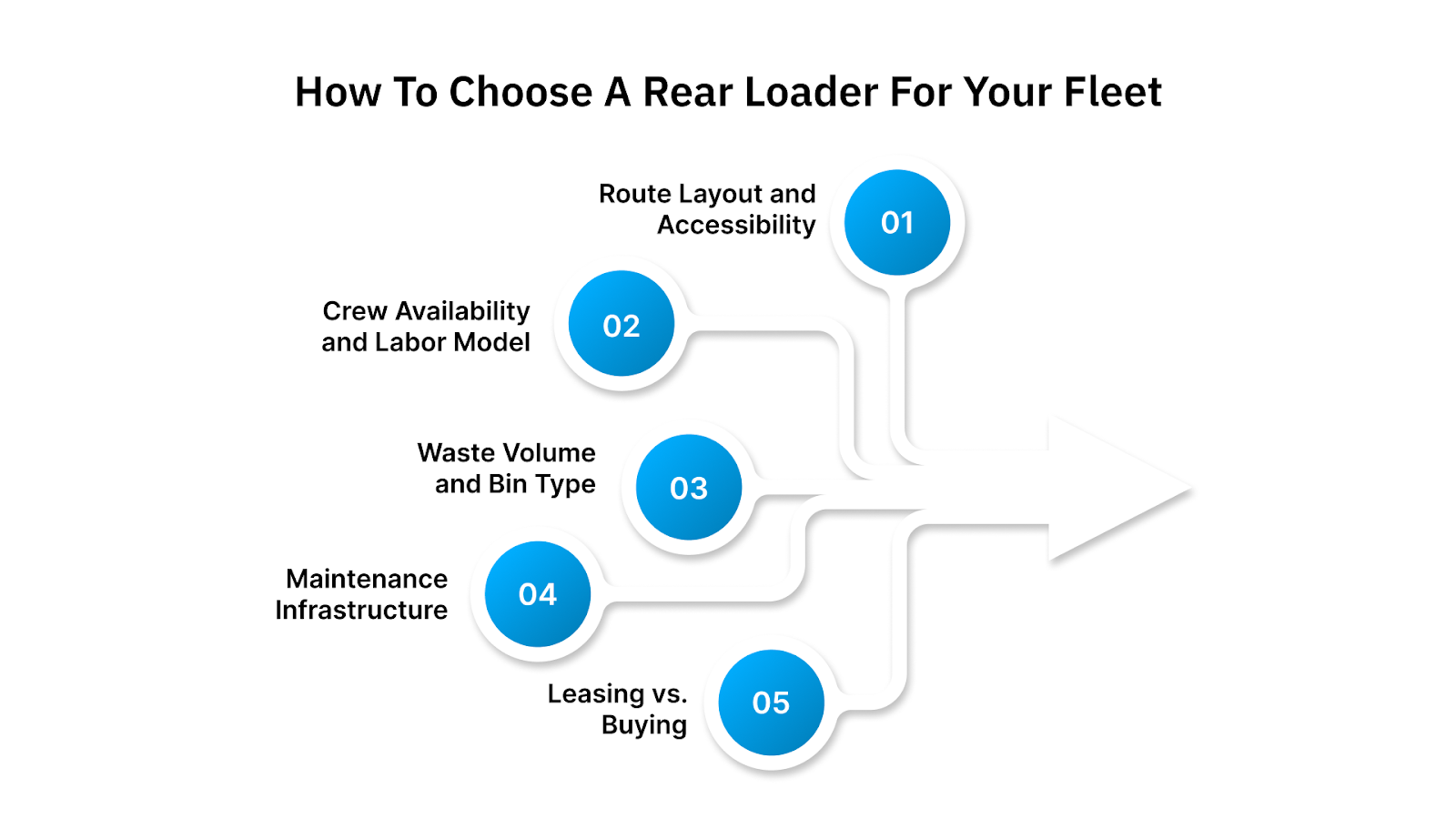
Rear loaders are only as good as their uptime. Once you’ve figured out what your operation needs from specs to crew setup, the next step is finding a truck that’s already prepped to perform. That’s where Trash Truck Rental comes in.
At Trash Truck Rental, we specialize in refuse-ready rear loader garbage trucks, designed, maintained, and delivered to support real-world waste operations.
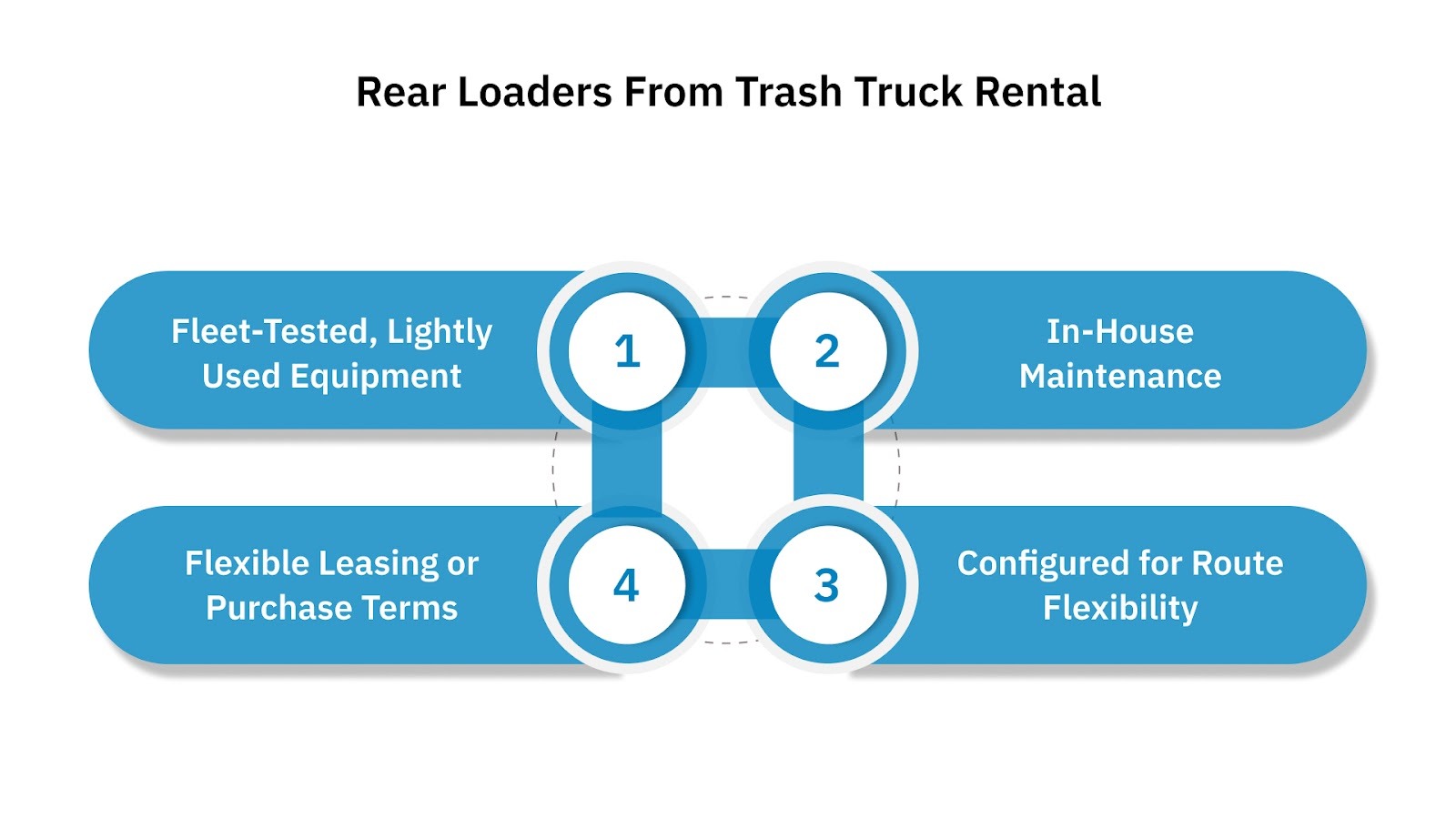
Here’s what sets us apart:
Our rear loaders are sourced from short-term service cycles, meaning:
Every truck goes through:
Our rear loaders come with:
Rear loaders aren’t just legacy trucks; they’re still one of the most versatile tools in modern waste management.
If you’re ready to add one to your fleet without the wait, guesswork, or long-term capital strain, Trash Truck Rental has a unit ready to roll.
A: Rear loaders are versatile; they can process household trash, commercial bin contents, light bulk items, and non-standard loads. Because crews load waste manually or via tippers, they can manage irregular volumes that automated trucks struggle with.
A: Typically, a rear loader operates with 2–3 crew members: a driver and one or two loaders. Some operations may also use a helper for heavy or bulk routes.
A: Key safety systems include emergency-stop buttons (cab & tailgate), compactor interlocks (to prevent operation when someone is in the danger zone), backup alarms, high-visibility lighting, and sensors or cameras for backing and proximity alerts.
A: With proper maintenance, rear loaders tend to last 7 to 12 years, depending on route intensity, compaction cycles, and upkeep.
A:
A: Leasing is ideal for covering seasonal demand, testing new models, or avoiding large capital expense. Buying is better when you’re scaling your fleet, standardizing your operation, and looking for long-term investment in assets.
A: Yes, if you choose the right configuration. Light-duty or mid-duty rear loaders with compact frames are well-suited for narrow routes and alleyways. The flexibility of manual loading gives them advantages over rigid automated de
Ready to Upgrade Your Process Operations?